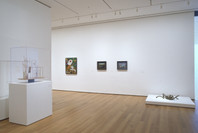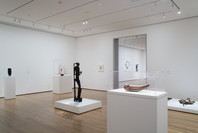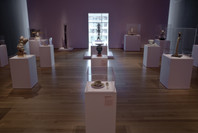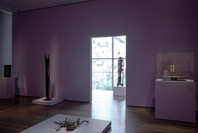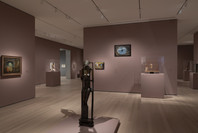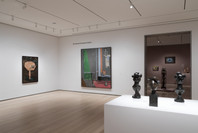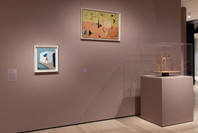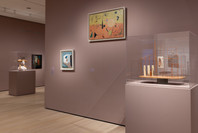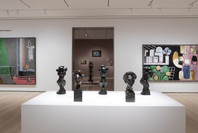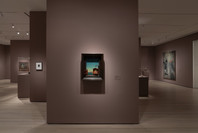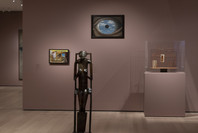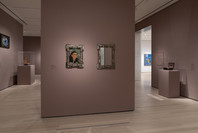In the Surrealist periodical Minotaure, Giacometti described the process that brought into being this fragile, air-filled sculpture. “This object formed little by little toward the end of summer 1932,” Giacometti recalled; “it gradually became clearer to me, the various parts taking their exact form and their particular place in the ensemble. Come autumn it had attained such a reality that its execution did not take me more than one day.” By privileging an interior mental image over the physical act of making, Giacometti affirmed his commitment to Surrealism’s call for the near-automatic recording of visions achieved in a dreamlike state.
Within his palace’s spindly, tenuously defined spaces, a slender sheet of suspended glass connects its rooms from left to right, adding to the structure’s vulnerable appearance. At right a delicate bird skeleton and sinuously curving vertebrae float, suspended, in space-frames or cages; at left a chess piece–like figure of a woman stands before three panels; at center is an enigmatic elliptical shape that the artist identified with himself. In the Minotaure account, Giacometti compared the whole to a “fragile palace of matches” that he and a woman he loved would build every night, only to watch it repeatedly collapse. His words give voice to key Surrealist preoccupations, including all-consuming desire, the power of memory, and the relationship between Eros and Thanatos—love and death.
Publication excerpt from MoMA Highlights: 375 Works from The Museum of Modern Art, New York (New York: The Museum of Modern Art, 2019)
In 1933, Giacometti published a statement describing his artistic process: "For many years I have executed only sculptures that have presented themselves to my mind entirely completed. I have limited myself to reproducing them in space without changing anything, without asking myself what they could mean.... The attempts to which I have sometimes given way, of conscious realization of a picture or even a sculpture, have always failed." The Palace at 4 a.m. with its spindly wood scaffolding, sheet of glass, and delicate skeletons is a vertical, immaterial drawing in space.
Gallery label from 2006.




